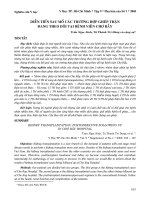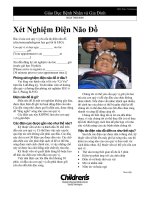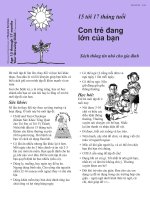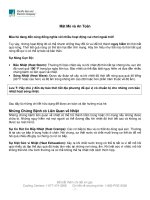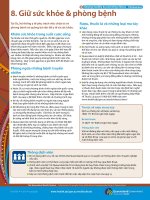Aeromedical-Transportation-A-Clinical-Guide.pdf
Bạn đang xem bản rút gọn của tài liệu. Xem và tải ngay bản đầy đủ của tài liệu tại đây (22.03 MB, 313 trang )
AeromedicAl trAnsportAtion
Aeromedical transportation
A clinical Guide
2nd edition
t. mArtin
Royal Hampshire County Hospital, Winchester, UK
CRC Press
Taylor & Francis Group
6000 Broken Sound Parkway NW, Suite 300
Boca Raton, FL 33487-2742
© 2006 by T. Martin
CRC Press is an imprint of Taylor & Francis Group, an Informa business
No claim to original U.S. Government works
Printed on acid-free paper
Version Date: 20160226
International Standard Book Number-13: 978-0-7546-4148-3 (Paperback)
This book contains information obtained from authentic and highly regarded sources. Reasonable efforts have been
made to publish reliable data and information, but the author and publisher cannot assume responsibility for the validity of all materials or the consequences of their use. The authors and publishers have attempted to trace the copyright
holders of all material reproduced in this publication and apologize to copyright holders if permission to publish in this
form has not been obtained. If any copyright material has not been acknowledged please write and let us know so we may
rectify in any future reprint.
Except as permitted under U.S. Copyright Law, no part of this book may be reprinted, reproduced, transmitted, or
utilized in any form by any electronic, mechanical, or other means, now known or hereafter invented, including photocopying, microfilming, and recording, or in any information storage or retrieval system, without written permission
from the publishers.
For permission to photocopy or use material electronically from this work, please access www.copyright.com (http://
www.copyright.com/) or contact the Copyright Clearance Center, Inc. (CCC), 222 Rosewood Drive, Danvers, MA 01923,
978-750-8400. CCC is a not-for-profit organization that provides licenses and registration for a variety of users. For
organizations that have been granted a photocopy license by the CCC, a separate system of payment has been arranged.
Trademark Notice: Product or corporate names may be trademarks or registered trademarks, and are used only for
identification and explanation without intent to infringe.
Visit the Taylor & Francis Web site at
and the CRC Press Web site at
contents
List of Figures
List of Tables
Preface to the Second Edition
Preface to the First Edition
Acknowledgements
List of Abbreviations
Glossary
PART I
vii
ix
xi
xiii
xv
xvii
xxi
INTRODUCTION
1
History of Aeromedical transportation
2
overview
PART II
3
13
PHYSICS AND PHYSIOLOGY
3
the Atmosphere
T. Martin and M. Glanfield
29
4
the physiological effects of Altitude
T. Martin and M. Glanfield
39
5
the Biodynamics of Flight
T. Martin and M. Glanfield
55
6
transmeridian and long Haul Flights
63
PART III
OPERATIONAL CONSIDERATIONS
7
operational Aspects of Aeromedical transport
77
8
the medical Flight crew
97
9
Aeromedical equipment
109
vi
Aeromedical Transportation: A Clinical Guide
PART IV CLINICAL CONSIDERATIONS
10
indications for Aeromedical transport
139
11
clinical considerations in transport of the ill and injured
149
12
transport of patients with spinal injuries
173
13
transport of Burns patients
181
14
transport of the obstetric patient
187
15
transport of neonatal and pediatric patients
193
16
critical care transfers and retrievals
209
17
nursing care in the Air
T. Martin and I. MacLennan
217
PART V ORGANIZATION AND ADMINISTRATION
18
the Administration of Aeromedical transport organizations
235
19
medicolegal Aspects of Aeromedical transport
243
20
planning the successful international repatriation
259
21
Primary Transfers: The Casualty Evacuation Conflict
279
Index
285
list of Figures
Figure 1.1
Figure 1.2
Figure 1.3
Figure 1.4
Figure 1.5
Figure 2.1
Figure 2.2
Figure 2.3
Figure 3.1
Figure 3.2
Figure 3.3
Figure 3.4
Figure 3.5
Figure 3.6
Figure 4.1
Figure 4.2
Figure 4.3
Figure 4.4
Figure 4.5
Figure 5.1
Figure 5.2
Figure 6.1
Figure 6.2
Figure 6.3
Figure 7.1
Figure 7.2
Figure 7.3
Figure 7.4
Figure 7.5
A douglas c-47 as used for casualty evacuation in
World War ii
Sikorsky YR-4 en route to the first helicopter casevac in
Burma, 1945
Bell UH-1 Huey, first used in the casevac role in Vietnam
Britain’s first helicopter air ambulance, First Air in cornwall
(courtesy cornwall & isles of scilly Ambulance service)
dedicated air ambulance (shandscair, Florida)
search and rescue helicopter of the royal Air Force
Boeing md explorer of the london Helicopter emergency
medical service
Military stretcher fit replacing a block of conventional seats
the atmosphere as a column
the three layers of the atmosphere
the pressure-volume relationship with altitude (dry gases)
Boyle’s and dalton’s laws
the position of the sun relative to the earth’s surface
patterns of air movement caused by vertical air currents
the oxygen partial pressure gradient from dry atmosphere to
minimum pressure level
the oxygen dissociation curve at 37oc and pH 7.4
Arterial po2 up to 20 000 ft (6100 m), breathing air
the concentration of oxygen required in the inspired gas to
maintain alveolar po2 of 13.3 kPa (100 mmHg)
relationship between gas volume and pressure at altitude
linear acceleration
radial acceleration
example of time-zone map
Virgin Atlantic Airways aromatherapy kit
sleep epochs either side of westbound and eastbound
long haul flights
Gates learjet
Raytheon Hawker 125/700
Beechcraft super King Air B200
Fairchild metroliner
eurocopter (Aerospatiale) dauphin
6
7
8
10
11
15
17
19
30
31
32
33
34
35
41
42
47
48
49
56
57
64
68
69
83
83
84
84
85
viii
Figure 7.6
Figure 7.7
Figure 7.8
Figure 8.1
Figure 8.2
Figure 9.1
Figure 9.2
Figure 11.1
Figure 11.2
Figure 11.3
Figure 11.4
Figure 12.1
Figure 12.2
Figure 15.1
Figure 15.2
Figure 15.3
Figure 19.1
Figure 19.2
Figure 20.1
Figure 20.2
Figure 20.3
Aeromedical Transportation: A Clinical Guide
Eurocopter (Bolkow) BK117
eurocopter ec135
Agusta Westland 109
Flight nurse and patient during a repatriation mission
Flight physician and paramedic team
Using a cargo lift for stretcher access to a commercial
airliner
An integrated loading and patient carriage system
dedicated air ambulance. note the space restrictions
and difficulty with stowage and access to equipment
Immobilization of the head and neck in suspected
cervical spine injury
Altitude equivalents for various levels of hemoglobin
Risk of rebleeding after an aneurysmal SAH
povey turning frame being loaded onto a military
Vc10 strategic casevac aircraft
Vacuum mattress conforms to the patient’s body
contours
intravenous access is often necessary before leaving
the referring hospital or scene of injury
BmJ paediatric resuscitation chart
nicU transport incubator
typical air ambulance transfer documentation
typical Hems documentation
Stretchers stacked on special mountings
Embarkation may best be achieved by means of
an elevator
loading a stretcher onto an air ambulance. note the
difficulty with access and lifting
85
86
86
99
99
111
115
150
152
160
166
176
176
198
199
206
249
251
271
272
273
list of tables
table 2.1
table 4.1
table 6.1
Table 6.2
Table 6.3
Table 7.1
Table 7.2
table 7.3
table 7.4
table 7.5
table 7.6
table 7.7
table 8.1
table 9.1
table 9.2
table 9.3
table 9.4
table 10.1
table 10.2
table 10.3a
table 10.3b
table 10.3c
table 10.3d
Features of the swedish national Air medevac program
21
the time of useful consciousness up to 36 000 ft (10 930 m) 53
American standard times
64
Flight time limitations for air ambulance flight crew
70
Summary of proposals for flight time limitations for
aeromedical personnel
71
Performance data for commonly used fixed wing
air ambulances
80
Typical fixed wing air ambulance cabin dimensions
80
comparison of typical helicopter air ambulances
82
safety matrix: factors in crash prevention and survival
89
essential issues of agreement between the aviation
and medical components of an aeromedical transport system 92
safety related policies/standard operating procedures
92
radio frequency band characteristics
95
A model curriculum based on the Air Medical
Crew National Standard Curriculum (UsA)
104
Hems typical onboard medical equipment and
specialist kit
112
Hems typical portable medical equipment
112
Recommendations of the RSM working party on
minimum standards in medical helicopter systems:
minimum acceptable equipment
114
typical air ambulance equipment
116-117
Guidelines for the use of aeromedical transport in
trauma patients
140
interhospital triage criteria
140
Guidelines for the use of aeromedical transport
in non-trauma medical and surgical patients
141
Guidelines for the use of aeromedical transport
in non-trauma pediatric patients
142
Guidelines for the use of aeromedical transport
in non-trauma neonatal patients
143
Guidelines for the use of aeromedical transport
in non-trauma patients in whom aeromedical
transport is not indicated
143
x
table 10.4
table 10.5
table 10.6a
table 10.6b
Table 11.1
table 11.2
table 11.3
table 11.4
table 13.1
Table 13.2
Table 13.3
table 15.1
table 15.2
table 15.3
table 16.1
table 16.2
table 16.3
Table 17.1
table 17.2
table 18.1
table 18.2
table 19.1
Table 19.2
table 19.3
Table 20.1
table 20.2
table 20.3
table 20.4
table 20.5
table 20.6
Table 20.7
table 21.1
Aeromedical Transportation: A Clinical Guide
outcome indicators for appropriate aeromedical
transport
injury and illness scoring for appropriate aeromedical
transport
Absolute contraindications to unescorted air travel
relative contraindications to unescorted air travel
Significant complications of myocardial infarction
Altitude restrictions for patients with cardiopulmonary
disease without supplemental oxygen
indications for intubation and ventilation after head injury
World Federation of neurosurgeons (WFn) grading for
sAH
the American Burns Association criteria for transfer
to a specialist burns unit
The ATLS recommended fluid regime for burns
Mount Vernon fluid resuscitation regimen
the wide variation in normal ranges of physiological
parameters in children
indications for neonatal transfer
typical neonatal transfer equipment
inter-icU transfers in the UK
the advantages and disadvantages of
different modes of transport
indications for iABc transport
Airlines’ classification of wheelchair usage
manufacturers’ estimations of inspired oxygen fraction
at various flow rates through nasal cannulae at sea level
model quality assurance/continuous quality improvement
program
proven hypotheses in aeromedical transport
elements of proof required in cases of negligence
Options when death occurs in flight
details of AAGBi/UK ics personal accident cover
The duties of the medical assistance desk doctor
patients considered to be ‘serious’
Key essentials for urgent and immediate repatriation
indications for upgrading of seats
indications for air ambulances and air taxis
logistic stages in repatriation assignments
Suggested medical escort flight time limitations
considerations in casualty evacuation
144
145
146
147
156
159
163
165
181
183
183
197
201
205
209
211
215
220
221
239
241
247
255
257
261
262
263
264
266
269
276
282
preface to the second edition
When the first edition of Aeromedical Transportation was published in 1996, i
could not have predicted the acceleration in interest and enthusiasm that was to take
place over the following decade. these years saw continued growth in aeromedical
activities and an upsurge in publications which are starting to bring our specialty in
from the cold. many of these papers are still of the anecdotal and case study type
design (level 5 evidence), but there has been enough original and well structured
research to light the path for an optimistic future. For an author, the next best thing
to seeing a new book published is acquisition of new facts and information from all
the research and essential reading needed to update and enlarge a previous edition.
As such, this work has been both a challenge and a pleasure to compile. In doing
so, I have acknowledged many new friends and colleagues who have contributed
in one way or another. to this list i must add the students who, under the guise of
being taught by me, have often reversed the roles and encouraged me to look at
aeromedical problems in a new light, to discover new ways of explaining complex
information, or in helping me develop new skills and techniques of teaching. To
paraphrase the words of Hippocrates ‘every doctor must be a teacher’ (to teach them
this art, should they desire to learn [it]), and my students have taught me well.
This book will continue to be the text for several aeromedical courses in English
speaking nations around the world, and it is encouraging to hear that it is already
being translated into swedish and spanish for wider use around europe. However,
like the first edition, I have included pet phrases from the medical and aviation
communities on both sides of the Atlantic, and the language is still placed firmly
somewhere halfway across the ocean. to ease the transition for those who still have
difficulty, the glossary of terms has been enlarged to match the increase in material
found in each chapter.
As well as more meat to each chapter, there are more references in the
bibliographies, and two new chapters have been added. The first, chapter 16, looks
more closely at the issues of critical care transfers – a rapidly growing subset of
aeromedical transports due to the regionalization of expensive health care facilities
and subspecialties. This new chapter takes a combined organizational and clinical
approach to critical care retrievals and transfers, highlighting areas where room for
improvement has been shown to exist, and offering tips to avoid the many potential
pitfalls that are there to trap the unwary.
One of my profoundest discoveries in the last decade of teaching was that flight
physicians often escort patients alone and yet have little concept of nursing care.
Chapter 17 addresses this gap in knowledge by discussing the important issues that
xii
Aeromedical Transportation: A Clinical Guide
bring flight nursing skills out of the woodwork! Doctors are encouraged to utilize
their time with flight nurse colleagues to develop a holistic approach to patient
care.
Aeromedical transportation has come a long way since the first edition was
published and is not so much a new kid on the specialty block anymore. However, the
new age has brought new challenges. increasing fuel costs, international terrorism,
larger aircraft, advances in medical technology, critical ‘expensive’ care, demands for
training, improvement and documentation of standards of care, and ever increasing
legislation – these are just some of the challenges that are being met in hospitals, in
helicopters, and high in the skies around the world on a daily basis.
novel air medical courses offered by the otago University in new Zealand are
helping to take this new specialty forward, and the next decade will see postgraduates
with masters and doctorates in patient transportation. this will be an exciting time for
the academic development of the subject and for the establishment of new research
programs and interests. As stated in the first edition, I look forward to chronicling
these developments in future editions and my goals remain the same – not just to
provide you, the reader, with an introduction to the world of aeromedical transport,
but also to intrigue and entice you to learn more. As such, the book is intended as a
basic primer for those who seek to work in transfer and retrieval medicine.
it wouldn’t be surprising if you view the transfer of a patient as a move from one
place of safety to another with a stressful and dangerous period of uncertainty between
the two. This is a view often shared by our terrestrial medical and nursing colleagues!
With this book as your flight companion, I hope you will acquire knowledge to plan
well, skill to assess all dangers and potential problems, yet humility to withdraw
when safety and wellbeing risk compromise.
preface to the First edition
Aeromedical transportation is the world of airborne cavalry coming to the rescue; of
saving one’s fellows by flying into the battle, borne on the wind, to snatch life from
the jaws of death.
At least that’s what the papers say! In truth, aeromedical practice usually
comprises hours of tedium waiting for an assignment, interspersed with periods
of sheer exhilaration and, just occasionally, moments of absolute terror. it is a
fascinating mix of physics and physiology, of aeronautics, clinical care, and the
thrill of flight, that combine to form one of the most unique and exciting fields of
medicine. In the age of international travel, with the globe shrinking a little each day,
aeromedical transport has become a routine facet of everyday life. no matter if you
are just an occasional flyer, or if the thrill of the emergency helicopter is the stuff of
your dreams, a career in aeromedical transportation may be your passport, and this
book can serve as your visa – sufficient to allow entry, but you’ll need a lifetime to
really get to know it.
The reader will notice an imbalance in this book between the established science
of aviation physiology and scientifically proven data and reports about clinical care
while aloft. It must be remembered that aeromedical transportation is a new kid on
the specialty block and, as such, does not yet possess the benefits and background of a
fully developed research and literature base. it is hoped that, as aeromedical services
continue to grow and document their efforts, this literature base will flourish. We
look forward to chronicling these developments in future editions of this text. For
now, the reader will find a relevant bibliography at the end of each chapter and a
general reading list in chapter 2.
A note about language is in order. The authors of this book share the belief of
George Bernard Shaw that Great Britain and America are two great English speaking
nations separated only by a common language. As a result, we have each had to
compromise on some pet phrases from the medical and aviation communities on
both sides of the ocean. The reader will kindly accept our placement of language
somewhere over the mid-Atlantic. to ease the transition for those who still
have difficulty, a glossary of interchangeable terms has been included. Units of
measurement throughout the book, are those most often used in either the aviation
or the medical fraternity, not necessarily their Système International equivalents.
drug names are given as generics with alternative names following in parentheses.
lastly, to avoid the cumbersome use of multiple pronouns and adjectives, we have
adopted the use of the male gender (‘he’, ‘him’, ‘his’) when, clearly, we mean to
xiv
Aeromedical Transportation: A Clinical Guide
refer to either gender. Similarly the term ‘man’ should be taken to mean human of
either sex.
our goal is not just to provide you, the reader, with an introduction to the world
of aeromedical transport, but also to intrigue and entice you to learn more. the
book is intended as a basic reference for those who seek to work in transportation
medicine, primarily doctors, but it will prove of great relevance and interest to flight
nurses, paramedics and those who administer air ambulance organizations and
other air medical flight programs. The book is now the standard text for the new
Clinical Considerations in Aeromedical Transportation training course in the UK
and, hopefully, will soon be adopted in other countries. The authorship reflects this
international approach which, we trust, is emulated throughout the text. It is difficult,
though, to fairly represent the vast variety of aeromedical systems that operate across
the globe and we do not claim to have written the definitive text. Nevertheless, we
have started the ball rolling, and we hope to have conveyed at least the flavor of this
exciting field. One does not need to understand the minutiae of cavalry tactics to
know that both Colonel Custer and the Light Brigade were deep in the mire. We hope
that this book will allow you the knowledge and comfort to advance in confidence,
and yet to retreat, quickly, when required.
Acknowledgements
We wish to thank all those who have taught and encouraged us over the years, on
both sides of the Atlantic, on distant airfields, and in skies around the world. Special
mention must be made of the royal Air Force, the United states Air Force, europ
Assistance, the royal london Hospital Helicopter emergency medical service,
shandscair Flight program at shands Hospital at the University of Florida, and
medical rescue international in Johannesburg, south Africa.
In particular, we wish to thank those who have taken the time and trouble to
read and give advice on this text. to the following, we are indebted: lt col John
crowley (Us Army medical corps); maj philip Johnson (royal Army medical
corps); dr Alexander campbell (medical and dental defence Union of scotland);
ms Bridget collier (europ Assistance); michael spencer, mrs Barbara stone, prof
david denison, dr rollin stott, and sgt rené metcalfe (Aeromedicine department
of the DERA Centre for Human Sciences). Thanks, also, to Sgt Andy Whittle, the
Cornwall and Isles of Scilly Ambulance Service, and Bridget Collier, for kindly
providing the photographs in Figures 1.2, 1.3 and 9.3 (respectively).
t.e. martin and H.d. rodenberg
July 1996
The text has been extensively reviewed in the second edition. I should like to thank
the major contributors, Dr Michael Glanfield and Mr Ian MacLennan for their input to
the new material. Some additional literature searches were undertaken by Dr Carmen
de Andres and much of the proofreading was completed by ms melanie robertson
and Ms Hannah Shepherd. In thanking the above, I also take full responsibility for
any errors, either factual or typographical, that remain in the text.
Finally, i welcome comments and correspondence, especially where disagreement
exists, or where omissions and oversights have occurred.
t.e. martin
2006
list of Abbreviations
AA
AAms
Acls
ADM
AGl
AHA
AIDS
Als
Ami
AmpA
Ams
ApAcHe
Ards
Atls
BAmpA
BAsics
Bls
BmJ
BPAP
BsA
BVM
cAA
cAAms
casevac
ccAt
ccU
cHF
cpAp
cpr
cQi
CRM
csd
CSF
ct
cVA
cVp
Automobile Association
Association of Air medical services
Advanced cardiac life support
Aeronautic decision making
Above ground level
American Heart Association
Acquired immune deficiency syndrome
Advanced life support
Acute myocardial infarction
Air medical physician’s Association
Aerial medical service
Acute physiology and chronic health evaluation
Acute respiratory distress syndrome
Advanced trauma life support
British Association of Aeromedical practitioners
British Association of immediate care (schemes)
Basic life support
British medical Journal
Bitlevel peak airway pressure
Body surface area
Bag-valve-mask system
civil Aviation Authority
commission on Accreditation of Aeromedical services
casualty evacuation
clinical considerations in Aeromedical transport (course)
coronary care unit
congestive heart failure
continuous positive airway pressure
cardiopulmonary resuscitation
continuous quality improvement
Cockpit resource management
cabin service director
Cerebrospinal fluid
computerized tomography
cerebrovascular accident
central venous pressure
xviii
DCS
deA
ems
emt-p
erc
et
etco2
eUrAmi
FAA
Fio2
fpm
Gcs
Gi
Gmt
HAZmAt
Hb
HbF
Hems
HIV
iABp
icAo
icp
icU
idl
IFR
ils
isA
isAs
iss
itU
iV
kPa
kt
loX
m
mmHg
MAST
MAST
mediF
mi
mph
mpm
mV
mVA
Aeromedical Transportation: A Clinical Guide
Decompression sickness
drugs enforcement Agency
emergency medical services
emergency medical technician – paramedic
european resuscitation council
endotracheal
end-tidal carbon dioxide
european Aero medical institute
Federal Aviation Administration
inspired oxygen concentration
Feet per minute
Glasgow coma score (or scale)
Gastrointestinal
Greenwich mean time
Hazardous material
Hemoglobin
Fetal hemoglobin
Helicopter emergency medical service
Human immunodeficiency virus
intra-aortic balloon pump
international civil Aviation organization
intracranial pressure
intensive care unit
international date line
Instrument flight rules
instrument landing system
international standard atmosphere
international society of Aeromedical services
injury severity score
intensive therapy unit
intravenous
Kilopascals
Knot (one nautical mile per hour)
liquid oxygen
meters
millimeters of mercury
Military assistance to safety and traffic
Medical (or military) antishock trousers
medical information form
myocardial infarction
miles per hour
meters per minute
minute volume
motor vehicle accident
List of Abbreviations
nAAs
nHs
nicU
nm
ntsB
pAco2
paco2
pAip
pao2
PASG
peep
piH
po2
prom
psi
ptl
QA
QAntAs
rAF
rAps
rem
sAmU
sAr
sAs
sBp
scBU
scn
simV
sl
spo2
STOL
sUmmA
SV
ts
UH
UK
Us
UsA
UsAF
Utc
VFR
Wc
national Association of Air Ambulance services (UK)
national Health service
neonatal intensive care unit
nautical miles
national transportation safety Board
Alveolar partial pressure of carbon dioxide
Arterial partial pressure of carbon dioxide
post-accident incident plan
Arterial partial pressure of oxygen
Pneumatic antishock garment
positive end expiratory pressure
pregnancy induced hypertension
partial pressure of oxygen
premature rupture of membranes
pounds per square inch
preterm labor
Quality assurance
Queensland and northern territories Air service
royal Air Force
rapid acute physiology score
rapid eye movement
service d’Aide médicale Urgente
search and rescue
scandinavian Air services
systolic blood pressure
special care baby unit
suprachiasmatic nucleus
synchronized intermittent mandatory ventilation
sea level
Venous oxygen saturation
Short take-off and landing
servicio de Urgencias médicas de madrid
Stroke volume
trauma score
Utility helicopter
United Kingdom
United states (of America)
United states of America
United states Air Force
Universal coordinated time
Visual flight rules
Water closet (lavatory)
xix
Glossary
the following words and phrases are used throughout the text. Where meaning may
be ambiguous, an alternative word or description is given.
aeromedical
aeromedical escort
aeromedical team
anesthesiologist
antennas
chart
desk doctor
diapering
dysrhythmia
electrocardiogram
emergency room
escort, attendant
family practitioner
fixed base operator
flight crew
flight following
flight physician
litter
matériel
medical flight crew
off-line
on-line
physician
rotary wing
scene flight
scoop and run
stay and play
air medical
air medical attendant, medical flight crew
doctor, nurse and/or paramedic flight crew
anaesthetist (UK)
aerials
medical document, hospital or transport notes
doctor working in the office of a medical
assistance organization
changing a nappy
arrhythmia
ecG, eKG
accident and emergency unit
member of aeromedical team
general practitioner, family doctor
supplier of fuel, maintenance
and other aviation services, based at an airport
aircrew, pilot and copilot
a radar and/or radio means of
keeping track of the whereabouts of an aircraft
aeromedical doctor, flight doctor, flight surgeon
stretcher
stores and supplies
team of aeromedical personnel
supervision from a distance, e.g. by telemetry
supervision on board
doctor (UsA), doctor practising internal medicine (UK)
rotorwing, helicopter
a primary response mission,
that is, flight direct to the scene of an incident
to collect the patient from the scene of injury with
little or no time or effort spent on stabilization
before evacuation
to spend time on scene in an effort to resuscitate
or stabilize a patient prior to evacuation
xxii
stopover
stretcher
veteran
Aeromedical Transportation: A Clinical Guide
overnight interruption during journey
litter
retired military personnel, ex-serviceman
pArt i
introduction

